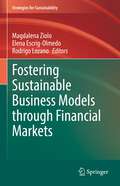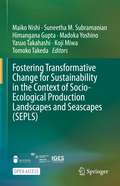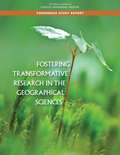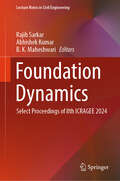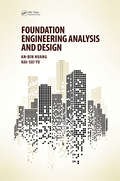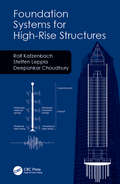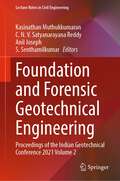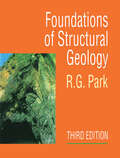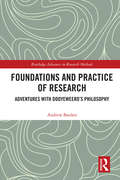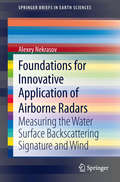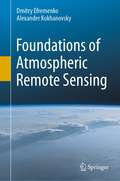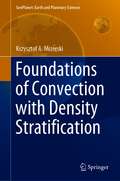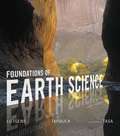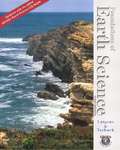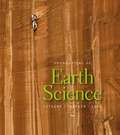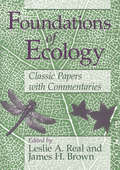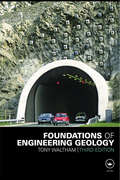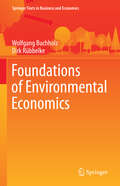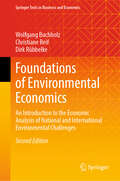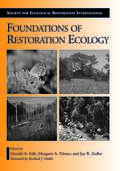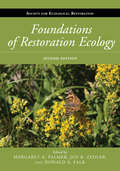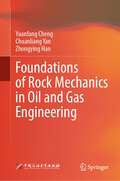- Table View
- List View
Fostering Sustainable Business Models through Financial Markets (Strategies for Sustainability)
by Magdalena Ziolo Rodrigo Lozano Elena Escrig-OlmedoThe aim of this volume is to foster more sustainable business models through financial markets. To that end, it is necessary to know the main global challenges facing financial markets and their impact on creating sustainable value in business models of enterprises in the context of sustainable adaptation. The book focuses on assessing the decision criteria adopted by financial markets in the process of transaction risk valuation, in terms of the presence of Environmental, Social, and Governance (ESG) criteria, and by assessing the impact of including these criteria in the risk assessment process by financial markets in business decisions, leading as a consequence to building new value in the form of a sustainable business model. The book presents global ESG risks facing the financial markets, and discusses how ESG risks are managed and monitored, and how financial markets can measure and operationalize extra-financial risks in its assessment process. The book also analyses ESG risk implications and influences on company behavior, and the actions that companies should take considering the ESG assessment requirements of financial markets. Finally, it provides a comprehensive, structured, and systematic view of how financial markets and companies should adapt and improve their business models. The book provides unique challenges for investors, companies, financial markets, and for our society as a whole, advancing traditional risk management approaches to address global risks.
Fostering Transformative Change for Sustainability in the Context of Socio-Ecological Production Landscapes and Seascapes (SEPLS)
by Himangana Gupta Maiko Nishi Suneetha M. Subramanian Madoka Yoshino Yasuo Takahashi Koji Miwa Tomoko TakedaThis open access book is a compilation of case studies that provide useful knowledge and lessons that derive from on-the-ground activities and contribute to policy recommendations, focusing on the relevance of social-ecological production landscapes and seascapes (SEPLS) to “transformative change.” The concept of “transformative change” has been gaining more attention to deal with today’s environmental and development problems, whereas both policy and scientific communities have been increasingly calling for transformative change toward sustainable society. The Intergovernmental Science-Policy Platform on Biodiversity and Ecosystem Services (IPBES) has planned to start the so-called “assessment on transformative change” if approved by the IPBES plenary to be held in 2021. At present, the idea of transformative change, including its scope, methodologies, approaches and strategies, are yet to be clarified. By bringing together all of the different concerns and interests in the land/seascape, SEPLS approaches could provide practical and experience-based insights for understanding and gauging transformative change and identifying determinants of such change. This book explores how SEPLS management relates to the idea of transformative change to further the discussion of sustainable transitions in advancing sustainability science. The introductory chapter is followed by case study chapters offering real-world examples of transformative change as well as a synthesis chapter clarifying the relevance of the case study findings to policy and academic discussions. It will be of interest to scholars, policymakers and professionals in the fields related to sustainable development.
Fostering Transformative Research in the Geographical Sciences
by Engineering Medicine National Academies of SciencesThe central purpose of all research is to create new knowledge. In the geographical sciences this is driven by a desire to create new knowledge about the relations between space, place, and the anthropogenic and non-anthropogenic features and processes of the Earth. But some research goes beyond these modest aims and creates new opportunities for further research, or affects the process of knowledge acquisition more broadly, or changes the way other researchers in a domain think about the world and go about their business. Due to its positive impacts, transformative research can be regarded as inherently having greater value than more conventional research, and funding agencies clearly regard transformative research as something to be encouraged and funded through special programs. Assessments of transformative research funding initiatives are few and provide a mixed picture of their effectiveness. The challenge is whether transformative research can be identified at the time it is proposed rather than after it has been conducted, communicated, and its influence on the discipline has become clear. Fostering Transformative Research in the Geographical Sciences reviews how transformative research has emerged in the past, what its early markers were, and makes recommendations for how it can be nurtured in the future.
Foundation Dynamics: Select Proceedings of 8th ICRAGEE 2024 (Lecture Notes in Civil Engineering #572)
by Abhishek Kumar Rajib Sarkar B. K. MaheshwariThis book will present the select proceedings of the 8th International Conference on Recent Advances in Geotechnical Earthquake Engineering and Soil Dynamics (8ICRAGEE) held at the Indian Institute of Technology (IIT), Guwahati between December 11 and 14, 2024. It contains the latest research papers covering the contributions and accomplishments in geotechnical earthquake engineering and soil dynamics in the last four years. The five volumes of the book cover a wide range of topics, including but not limited to seismic hazard analysis, wave propagation and site characterization, dynamic properties and liquefaction of soils, pile foundations, offshore foundations, seismic design of retaining structures and dams, seismic slope stability and landslides, dynamic soil-structure interaction, seismic design of structures. Further, recent developments on these topics are covered in different chapters. This book will be valuable not only for researchers and professionals but also for drawing an agenda for future courses of action from the perspective of geotechnical earthquake engineering, keeping the national need at the forefront.
Foundation Engineering Analysis and Design
by Hai-Sui Yu An-Bin HuangOne of the core roles of a practising geotechnical engineer is to analyse and design foundations. This textbook for advanced undergraduates and graduate students covers the analysis, design and construction of shallow and deep foundations and retaining structures as well as the stability analysis and mitigation of slopes. It progressively introduces critical state soil mechanics and plasticity theories such as plastic limit analysis and cavity expansion theories before leading into the theories of foundation, lateral earth pressure and slope stability analysis. On the engineering side, the book introduces construction and testing methods used in current practice. Throughout it emphasizes the connection between theory and practice. It prepares readers for the more sophisticated non-linear elastic-plastic analysis in foundation engineering which is commonly used in engineering practice, and serves too as a reference book for practising engineers. A companion website provides a series of Excel spreadsheet programs to cover all examples included in the book, and PowerPoint lecture slides and a solutions manual for lecturers. Using Excel, the relationships between the input parameters and the design and analysis results can be seen. Numerical values of complex equations can be calculated quickly. non-linearity and optimization can be brought in more easily to employ functioned numerical methods. And sophisticated methods can be seen in practice, such as p-y curve for laterally loaded piles and flexible retaining structures, and methods of slices for slope stability analysis.
Foundation Systems for High-Rise Structures
by Deepankar Choudhury Rolf Katzenbach Steffen LepplaThe book deals with the geotechnical analysis and design of foundation systems for high-rise buildings and other complex structures with a distinctive soil-structure interaction. The basics of the analysis of stability and serviceability, necessary soil investigations, important technical regulations and quality and safety assurance are explained and possibilities for optimised foundation systems are given. Additionally, special aspects of foundation systems such as geothermal activated foundation systems and the reuse of existing foundations are described and illustrated by examples from engineering practice.
Foundation and Forensic Geotechnical Engineering: Proceedings of the Indian Geotechnical Conference 2021 Volume 2 (Lecture Notes in Civil Engineering #295)
by C. N. V. Satyanarayana Reddy Kasinathan Muthukkumaran Anil Joseph S. SenthamilkumarThis book comprises the select peer-reviewed proceedings of the Indian Geotechnical Conference (IGC) 2021. The contents focus on Geotechnics for Infrastructure Development and Innovative Applications. This book covers topics related to shallow foundations, pile & piled raft foundation, geotechnical design of foundation, wind turbine foundation, foundations on problematic soils, forensic geotechnical engineering, and case studies on geotechnical failures. This book is of interest to those in academia and industry.
Foundation of Structural Geology
by R G ParkSince the first edition was published in 1983, this highly-regarded introductory textbook has been used by many generations of students worldwide. It is specifically tailored to the requirements of first or second year geology undergraduates.The third edition has been extensively revised and updated to include many new sections and over 50 new or redrawn illustrations. There are now over 220 illustrations, many incorporating a second colour to highlight essential features. The format has been changed to enhance the visual attractiveness of the book.The tripartite organization of the first and second editions has been modified by combining the purely descriptive or factual aspects of fault and fold structure in the earlier chapters with a simple treatment of mechanisms, leaving the more geometrically complex treatment until after the relevant sections on stress and strain, as before. Some subjects are introduced for the first time, e.g. inversion and orogen collapse, and others have been extensively modified, e.g. the chapter on gravity controlled structures now emphasises modern work on salt tectonics. The last third of the book is devoted to the wider context of geological structures and how they relate to plate tectonics. The final two chapters have been considerably expanded and give examples of various types of geological structures in their plate tectonic settings in both modern and ancient orogenic belts.
Foundations and Practice of Research: Adventures with Dooyeweerd's Philosophy (Routledge Advances in Research Methods)
by Andrew BasdenMany of the issues on which meaningful research is founded are seldom discussed; for example, the role of everyday experience, diversity and coherence of meaning in the world, the meaningfulness and wider mandate of research, the very nature and validity of theoretical thought, and the deep presuppositions of philosophy and how they undermine the success of research. Such questions are material to the philosophies that guide research thinking in all fields, and since they cannot be satisfactorily addressed in a piecemeal fashion, this book employs the radically different philosophy of Herman Dooyeweerd to consider them together. Parts I and II discuss these issues theoretically and philosophically, while Part III discusses them practically, specifically the adventures that researchers across the world have had using Dooyeweerd's philosophy. Foundations and Practice of Research assembles a wide range of experiences of using Dooyeweerd's philosophy in research in the fields of mathematics, the natural sciences, the social sciences, design sciences and the humanities. Case studies demonstrate how Dooyeweerd's philosophy has been found fruitful in most stages of research, and the philosophical discussion backs this up. This book challenges researchers to join the adventures, including suggestions of potential research that could be carried out, as well as questions still left unanswered.
Foundations for Innovative Application of Airborne Radars
by Alexey NekrasovThe 'wind vector' - wind speed and direction - is a main meteorological quantity and relevant for air-sea exchange processes. This book explores the use of several airborne microwave instruments, some of which are part of standard aircraft equipment, in determining the local wind vector over water. This is worthwhile as local wind information is usually only available at measurements sites like weather stations and airports, and global wind information from satellites has very coarse resolution and poor temporal coverage - at most a few times daily. In his book, Nekrasov uses known results in a novel way and gives explicit and application-oriented descriptions how to additionally retrieve local wind information from standard airborne microwave instruments. The results presented here are highly valuable for flight operation above the sea (e. g. , search-and-rescue) but also for complementing other measurements of atmospheric or oceanic parameters during research flights.
Foundations of Atmospheric Remote Sensing
by Dmitry Efremenko Alexander KokhanovskyTheoretical foundations of atmospheric remote sensing are electromagnetic theory, radiative transfer and inversion theory. This book provides an overview of these topics in a common context, compile the results of recent research, as well as fill the gaps, where needed. The following aspects are covered: principles of remote sensing, the atmospheric physics, foundations of the radiative transfer theory, electromagnetic absorption, scattering and propagation, review of computational techniques in radiative transfer, retrieval techniques as well as regularization principles of inversion theory. As such, the book provides a valuable resource for those who work with remote sensing data and want to get a broad view of theoretical foundations of atmospheric remote sensing. The book will be also useful for students and researchers working in such diverse fields like inverse problems, atmospheric physics, electromagnetic theory, and radiative transfer.
Foundations of Convection with Density Stratification (GeoPlanet: Earth and Planetary Sciences)
by Krzysztof A. MizerskiThis book continues the process of systematization of knowledge about convection. It is important to put the current knowledge on weakly and strongly stratified convection in order, and provide a comprehensive description of the marginal, weakly nonlinear and fully developed stages of convective flow in both cases. The book provides a short compendium of knowledge on the linear and weakly nonlinear limits of the Boussinesq convection, and a review of the theory on fully developed Boussinesq convection. The third chapter is devoted to a detailed derivation and a study of the three aforementioned stages of stratified (anelastic) convection, with a full solution in the marginal stage provided for the first time. Detailed and systematic explanations are given. The book is intended mainly as a textbook for courses on hydrodynamics and convective flows, for the use of lecturers and students; however, it also serves for the entire scientific community as a practical reference.
Foundations of Earth Science
by Frederick K. Lutgens; Edward J. TarbuckIdeal for undergraduates with little or no science background, Foundations of Earth Science provides a student-friendly, highly visual, non-technical survey of our physical environment with balanced, up-to-date coverage of geology, oceanography, astronomy, and meteorology. Foundations of Earth Science is the brief, paperback version of the best-selling Earth Science by Lutgens and Tarbuck, and designed for introductory courses in Earth science. The new 8th Edition facilitates active learning by incorporating learning objectives throughout each chapter to provide students with a structured learning path. The learning path is tied to chapter objectives, giving students opportunities to demonstrate their understanding at the end of each section.
Foundations of Earth Science (3rd edition)
by Edward J. Tarbuck Frederick K. LutgensThis book offers a user-friendly overview of the physical environment. It retains the hallmarks expected from author's reader-friendly writing style, carefully crafted art program, and coverage of the most recent current events. It discusses key topics such as Earth materials, earth's external and internal processes, Earth's history, the global ocean, and the atmosphere.
Foundations of Earth Science 6th Edition
by Frederick K. Lutgens Edward J. Tarbuck.Earth Science by Lutgens and Tarbuck is designed for introductory courses in Earth science. It's a non-technical survey with broad, up-to-date coverage of basic topics and principles in geology, oceanography, meteorology, and astronomy. As in previous editions, the main focus is to increase your understanding of basic Earth science principles.
Foundations of Ecology: \Classic Papers with Commentaries
by Leslie A. Real and James H. BrownAssembled here for the first time in one volume are forty classic papers that have laid the foundations of modern ecology. Whether by posing new problems, demonstrating important effects, or stimulating new research, these papers have made substantial contributions to an understanding of ecological processes, and they continue to influence the field today. The papers span nearly nine decades of ecological research, from 1887 on, and are organized in six sections: foundational papers, theoretical advances, synthetic statements, methodological developments, field studies, and ecological experiments. Selections range from Connell's elegant account of experiments with barnacles to Watt's encyclopedic natural history, from a visionary exposition by Grinnell of the concept of niche to a seminal essay by Hutchinson on diversity. Six original essays by contemporary ecologists and a historian of ecology place the selections in context and discuss their continued relevance to current research. This combination of classic papers and fresh commentaries makes Foundations of Ecology both a convenient reference to papers often cited today and an essential guide to the intellectual and conceptual roots of the field. Published with the Ecological Society of America.
Foundations of Engineering Geology
by Tony Waltham A.C. WalthamNow in full colour, the third edition of this well established book provides a readable and highly illustrated overview of the aspects of geology that are most significant to civil engineers.Sections in the book include those devoted to the main rock types, weathering, ground investigation, rock mass strength, failures of old mines, subsidence on peats and clays, sinkholes on limestone and chalk, water in landslides, slope stabilization and understanding ground conditions. The roles of both natural and man-induced processes are assessed, and this understanding is developed into an appreciation of the geological environments potentially hazardous to civil engineering and construction projects. For each style of difficult ground, available techniques of site investigation and remediation are reviewed and evaluated.Each topic is presented as a double page spread with a careful mix of text and diagrams, with tabulated reference material on parameters such as bearing strength of soils and rocks. This new edition has been comprehensively updated and covers the entire spectrum of topics of interest for both students and practitioners in the field of civil engineering.
Foundations of Environmental Economics (Springer Texts in Business and Economics)
by Wolfgang Buchholz Dirk RübbelkeThis textbook provides a solid introduction to the theoretical and empirical aspects of environmental economics, and their links to environmental policy. It advocates drawing on the economist’s toolbox as a powerful means of finding solutions to environmental problems by addressing the conflict between the societal costs of pollution on the one hand, and the financial costs of emissions reduction on the other. The book presents the main economic theory approaches to handling environmental problems and assessing the monetary value of environmental quality; the most relevant environmental policy instruments and challenges involved in their effective real-world application; and both national and global environmental problems addressed by environmental negotiations and agreements. Given its scope, the book offers a valuable basis of information for students, and for policymakers pursuing effective environmental policies.
Foundations of Environmental Economics: An Introduction to the Economic Analysis of National and International Environmental Challenges (Springer Texts in Business and Economics)
by Wolfgang Buchholz Dirk Rübbelke Christiane ReifThis textbook provides a solid introduction to the theoretical and empirical aspects of environmental economics and their links to environmental policy. In this second edition, all chapters have been updated and restructured, and new sections have been added to reflect a greater focus on climate policy. Starting from the need to balance the social costs of pollution against the financial costs of emission abatement, the book discusses the major issues that arise in the context of environmental policy – such as the potential and limitations of monetary valuation of the environment (and in particular the contingent valuation method) and the design of environmental policy. With regard to the choice of environmental policy instruments, the book focuses on the price-based instruments preferred by economists, i.e., environmental taxes and emissions trading, discussing in detail not only their many advantages but also their drawbacks. The second edition especially focuses on green industrial policy as a complementary measure to price-based instruments, the distributional effects of environmental policies, and the resulting challenges for political feasibility. Moreover, the book deals extensively with international environmental problems, in particular climate protection, which is a global public good that will be underprovided when certain countries refuse to cooperate and contribute. Approaches to overcoming this underprovision are described in far more detail than in the first edition, both theoretically and empirically – in particular by assessing the functions of the many international environmental agreements in this field. Finally, a new chapter considers adaptation strategies, especially in the water sector, as an additional pillar of climate policy.
Foundations of Mathematics and Physics One Century After Hilbert: New Perspectives
by Joseph KouneiherThis book explores the rich and deep interplay between mathematics and physics one century after David Hilbert’s works from 1891 to 1933, published by Springer in six volumes. The most prominent scientists in various domains of these disciplines contribute to this volume providing insight to their works, and analyzing the impact of the breakthrough and the perspectives of their own contributions. The result is a broad journey through the most recent developments in mathematical physics, such as string theory, quantum gravity, noncommutative geometry, twistor theory, Gauge and Quantum fields theories, just to mention a few. The reader, accompanied on this journey by some of the fathers of these theories, explores some far reaching interfaces where mathematics and theoretical physics interact profoundly and gets a broad and deep understanding of subjects which are at the core of recent developments in mathematical physics. The journey is not confined to the present state of the art, but sheds light on future developments of the field, highlighting a list of open problems. Graduate students and researchers working in physics, mathematics and mathematical physics will find this journey extremely fascinating. All those who want to benefit from a comprehensive description of all the latest advances in mathematics and mathematical physics, will find this book very useful too.
Foundations of Quantum Mechanics (Lecture Notes in Physics #1003)
by Roderich TumulkaThis book introduces and critically appraises the main proposals for how to understand quantum mechanics, namely the Copenhagen interpretation, spontaneous collapse, Bohmian mechanics, many-worlds, and others. The author makes clear what are the crucial problems, such as the measurement problem, related to the foundations of quantum mechanics and explains the key arguments like the Einstein-Podolsky-Rosen argument and Bell’s proof of nonlocality. He discusses and clarifies numerous topics that have puzzled the founding fathers of quantum mechanics and present-day students alike, such as the possibility of hidden variables, the collapse of the wave function, time-of-arrival measurements, explanations of the symmetrization postulate for identical particles, or the nature of spin. Several chapters are devoted to extending the different approaches to relativistic space-time and quantum field theory. The book is self-contained and is intended for graduate students and researchers who want to step into the fundamental aspects of quantum physics. Given its clarity, it is accessible also to advanced undergraduates and contains many exercises and examples to master the subject.
Foundations of Restoration Ecology (Science Practice Ecological Restoration)
by Richard J. Hobbs Joy Zedler Margaret Palmer Donald A. FalkAs the practical application of ecological restoration continues to grow, there is an increasing need to connect restoration practice to areas of underlying ecological theory. Foundations of Restoration Ecology is an important milestone in the field, bringing together leading ecologists to bridge the gap between theory and practice by translating elements of ecological theory and current research themes into a scientific framework for the field of restoration ecology.Each chapter addresses a particular area of ecological theory, covering traditional levels of biological hierarchy (such as population genetics, demography, community ecology) as well as topics of central relevance to the challenges of restoration ecology (such as species interactions, fine-scale heterogeneity, successional trajectories, invasive species ecology, ecophysiology). Several chapters focus on research tools (research design, statistical analysis, modeling), or place restoration ecology research in a larger context (large-scale ecological phenomena, macroecology, climate change and paleoecology, evolutionary ecology).The book makes a compelling case that a stronger connection between ecological theory and the science of restoration ecology will be mutually beneficial for both fields: restoration ecology benefits from a stronger grounding in basic theory, while ecological theory benefits from the unique opportunities for experimentation in a restoration context.Foundations of Restoration Ecology advances the science behind the practice of restoring ecosystems while exploring ways in which restoration ecology can inform basic ecological questions. It provides the first comprehensive overview of the theoretical foundations of restoration ecology, and is a must-have volume for anyone involved in restoration research, teaching, or practice.
Foundations of Restoration Ecology (The Science and Practice of Ecological Restoration Series)
by Donald A. Falk Joy B. Zedler Karen Holl Margaret A. PalmerThe practice of ecological restoration, firmly grounded in the science of restoration ecology, provides governments, organizations, and landowners a means to halt degradation and restore function and resilience to ecosystems stressed by climate change and other pressures on the natural world. Foundational theory is a critical component of the underlying science, providing valuable insights into restoring ecological systems effectively and understanding why some efforts to restore systems can fail. In turn, on-the-ground restoration projects can help to guide and refine theory, advancing the field and providing new ideas and innovations for practical application.This new edition of Foundations of Restoration Ecology provides the latest emerging theories and ideas in the science of restoration ecology. Fully one-third longer than the first edition and comprehensive in scope, it has been dramatically updated to reflect new research. Included are new sections devoted to concepts critical to all restoration projects as well as restoration of specific ecosystem processes, including hydrology, nutrient dynamics, and carbon. Also new to this edition are case studies that describe real-life restoration scenarios in North and South America, Europe, and Australia. They highlight supporting theory for restoration application and other details important for assessing the degree of success of restoration projects in a variety of contexts. Lists at the end of each chapter summarize new theory introduced in that chapter and its practical application.Written by acclaimed researchers in the field, this book provides practitioners as well as graduate and undergraduate students with a solid grounding in the newest advances in ecological science and theory.
Foundations of Rock Mechanics in Oil and Gas Engineering
by Yuanfang Cheng Chuanliang Yan Zhongying HanThis book introduces the basic theoretical knowledge of rock mechanics and its application in petroleum engineering. It covers the gamut of the formulas and calculations for petroleum engineers that have been compiled over decades, while others are meant to help guide the engineer through some of the more recent breakthroughs in the industry’s technology.The topics are introduced at a level that should give a good basic understanding of the subject:• Basic concepts of stress and strain• Experimental method of rock mechanics• Rock deformation and strength characteristics• Rock strength failure criterion• In situ stress state• Application method of rock mechanics theory in the field of wellbore stability• Application method of rock mechanics theory in the field of sand production• Application method of rock mechanics theory in the field of hydraulic fracturing.This textbook contains abundant figures, illustrations, and tables, providing valuable examples and exercises.Key Features and Benefits for the Reader: • Helps in understanding the basic concepts of rock mechanics• Applies rock mechanics theory and method to various fields of petroleum engineering• Includes a large number of calculations, tables, and equations that are very useful for petroleum engineers• Presents new and updated sections in rock mechanics of petroleum engineering.
